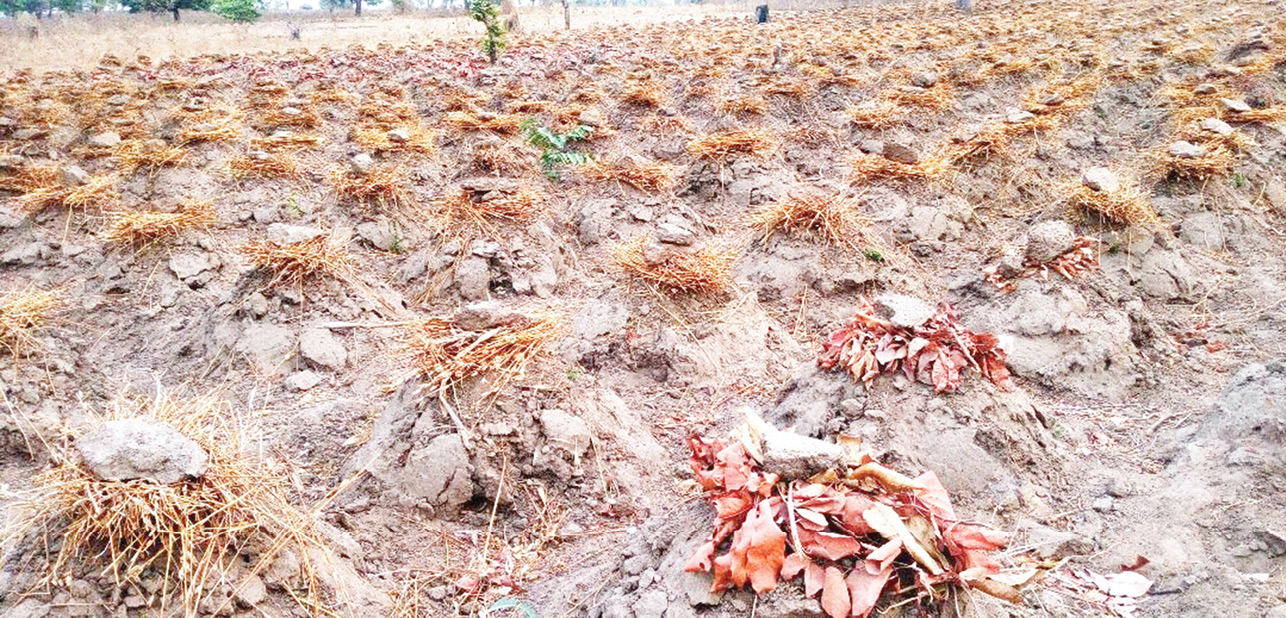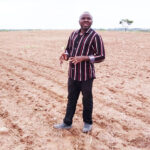With the start of the first rain already recorded in several of the planting zones, yam farmers in Benue, Niger, Nasarawa, Taraba, and other states are already planting or preparing their fields for cultivation.
This comes amid complaints that a severe financial shortage is weighing heavily on many of them, making it challenging for them to buy seed, herbicides and other inputs.
Although the Nigerian Meteorological Agency (NiMET) had forecast early rainfall this year, experts cautioned farmers not to sow their crops with the arrival of the first rain, which is anticipated to begin in April or May in the central regions of the country.
However, because yam is typically planted during a dry wind spell at the start of the planting season, it is not necessary for it to rain. For the time being, growers are obliged to wait for rain due to climate change, which brought the extreme heat that yam cannot handle.
- BREAKING: INEC bars party agents, journalists from Lagos collation centre in Somolu
- 10th NASS: APC yet to zone leadership positions, Adamu insists
Nonetheless, majority of farmers in Benue, Taraba and Nasarawa began planting their yams on March 10 with the arrival of the first rain, while others are now constructing their heaps in anticipation to start planting as soon as the second rain falls.
In Benue, Terdue Atondo, a yam farmer in the Gboko area, told our correspondent that he had already planted his yam, with the expectation that it would begin to sprout soon after the first rain on Friday last week because his heaps were moulded around October and November last year.
Atondo said his challenge was basically the high cost of insecticides, which he applied to the seedlings before planting to prevent termites and other insects from ruining his plants, coupled with naira scarcity.
“In the rural areas, most people don’t have bank accounts, so one has to travel to the city like Makurdi to be able to make purchases through means other than cash. This move is not palatable for farmers in the state,” he said.
Atondo said his farm of 200 lines containing 52 heaps on each line cost him a minimum of N5,000 per kilo of insecticides, which when multiplied, would make the amount he spent so far very high.
He said early planting of seedlings would enable them to germinate before the rain starts, and harvest would, therefore, take place between June and July this year.
However, Aboje Ogli, another yam farmer in Otukpo appeared indifferent because of the poor harvest he recorded in the previous seasons.
“I am no longer planting yam because of poor yield. I have decided to concentrate on other tuber crops like cassava. I bought costly herbicides for my yam farm previously and got nothing at the end. So, I have decided to stop it,” Ogli said.
For Favour Ekoja, who cultivated his field in the last trimester of 2022, after which he planted his yam, the first rain would aid the seedlings to germinate fast, thereby leading to early harvest.
He explained, “During the dry season like this, farmers plant their yams. Those who didn’t make yam heaps (mostly around October to early December) before the dry season use this time to prepare their ground so that immediately the rainy season starts they will start making their heaps. Take note that mulching materials are placed on every heaps that yam is planted in during this dry period, but not so when the rainy season comes.
“The reason for placing mulching materials on the top of the heap is to prevent the yam seedlings planted from being scorched (destroyed) by the heat of the sun.
“Some steps I took to cultivate my yam farm include clearing the bushes, tilling the soil and making heaps. Yam heaps are bigger than cassava heaps. I planted quality yam seedlings.”
The chairman of Yam Farmers Association in Benue State, Mrs Scholarstica Amua, said some people had already planted while others were in the process of doing so.
“Those who prepared their heaps in September last year have already planted. Those of us who didn’t make it are just clearing our lands. We have the challenge of inputs – herbicide, fertiliser and labour – so costly.
“The naira scarcity has affected farmers seriously. We don’t have money to pay for labour or buy the herbicides we need; and the cost has risen. There is no money at all; and Point of Sale (PoS) outlets charge N3,000 for every N10,000. That’s too much,” Amua said.
Also, the state chairman of the All Farmers Association of Nigeria (AFAN), Comrade Aondongu Saaku, emphasised the need for those who planted in September to heavily mulch their heaps so that as the rain begins, the crop would germinate faster and not get rotten under intense heat.
Saaku said the farmers who cultivated last year when it was still raining had started planting their yams, but those who didn’t do so can’t start planting now as they would wait for the second rain to come before they make their heaps.
In Nasarawa, many farmers have reportedly switched from early planting to late planting due to concerns with theft, destruction of heaps by animals and extreme heat.
“Last year, I lost almost half of the 4,000 heaps made because thieves invaded the farm in the night and removed the seeds, Musa Ayala told Daily Trust on Sunday in Agyragu town.
He added that because of poverty and the high cost of yam, there were people who go about removing seeds and sell to other farmers to buy at cheaper prices, adding that some farmers have to watch their farms at night.
A farmer in Doma, Stephen Audu, mentioned price as another factor influencing individuals to steal yam seeds. He said that to buy decent yam seedlings, which are often sold in packs of 100, you would require more than N50,000. As a result, depending on the size of the seeds, 200 pieces will probably yield between N150,000 and N200,000, making robbers to target yam seeds.
The issue, for other farmers, is extreme heat, which most seeds can no longer withstand. The availability of grasses to cover the piles in Nasarawa has significantly decreased as a result of the abundance of animals roaming around in search of hay and the situation in neighbouring Benue State.
In Niger State, our correspondent said that as new yam planting season begun, farmers and traders have lamented over low patronage to scarcity of naira notes.
Findings by our correspondent at Paiko and and Gunu markets revealed low supply of yam, including seedlings to the markets, as well as low patronage due to the scarcity of naira notes.
Farmers told our correspondent that the scarcity of naira notes would negatively impact on farming activities this rainy season if nothing is quickly done to make the cash available.
In Paiko market, the headquarters of Paikoro Local Government Area, one of the farmers and seller, Umar Mohammed, said the scarcity of naira notes had made the price of yam seedlings to fall, yet buyers were not rushing to buy as sellers preferred cash.
“With N20,000 you can get 100 yam seedlings. This scarcity of naira notes has truly reduced the purchasing power of rural people. We don’t accept transfer because even if buyers send you money, you need cash to buy some things. Most of us don’t accept transfer. The seedlings you can buy at the cost of N20,000 or N30,000 would cost you like N50,000 to get last year,” he said.
He said sellers were still scared of accepting the old N500 and N1,000 notes despite a directive by the Central Bank of Nigeria (CBN) because of the inconsistency in compliance among commercial banks and the inability to buy with the notes in the markets.
At Gunu market, Shiroro Local Government, farmers and traders said the prices ranged between N35,000 and N110,000, depending on the size and quality of seedlings despite the low supply to the market due to naira scarcity.
One of the sellers, Tanko Isah said, “Fifty seedlings, which is half a kwarya, is N35,000 and N45,000, depending on size and quality. But truly, people have not bought as much seedlings as they bought last year. Last year, despite the cost, people were rushing to the market to buy. But this time around, as you bring it to the market is how you return with it because there is no cash.”
At the Tungan-Mallam market, Daily Trust on Sunday gathered that prices of animals such as rams, goats and cows had also fallen.
Isah Mohammed, one of the sellers, told Daily Trust on Sunday that “the goat that cost N45,000 before now is being sold at N20,000. Traders just sell their animals at a giveaway price once you hold cash; they wouldn’t want to let go of the cash. So, at the end of the day, they let buyers take the animal for the cash he has.”
By Vincent A. Yusuf, Abuja, Hope Abah Emmanuel, Makurdi & Abubakar Akote, Minna




